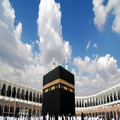The forthcoming Islamic festival of Eid Al Adha, symbolizing sacrifice, holds immense significance for millions of Muslims worldwide.
However, its observance varies across nations, contingent upon the sighting of the crescent moon.
Saudi Arabia, commencing the Islamic month of Dhul Hijjah upon the sighting of the moon on Thursday, is set to observe Eid Al Adha on June 16. Conversely, Oman anticipates the commencement of Dhul Hijjah on June 8, with Eid Al Adha slated for June 17, in accordance with the invisible crescent moon observed on Thursday. Egypt confirmed the moon sighting on Thursday, marking the beginning of Dhul Hijjah on June 7 and aligning the celebration of Eid Al Adha with Saudi Arabia on June 16.
Australia's fatwa council, mirroring Saudi Arabia, designates June 16 as the start of Eid Al Adha festivities. Despite efforts, New Zealand's Federation of Islamic Associations couldn't spot the Moon on Friday, leading to Dhul Hijjah starting on June 9 and Eid Al Adha on June 18. Brunei's Moon sighting on Friday initiates Dhul Hijjah on June 8, with Eid Al Adha scheduled for June 17. Moon-sighting teams in Canada reported no sightings on Thursday, setting Dhul Hijjah to commence on June 8, with Eid Al Adha falling on June 17.
Similarly, the Central Hilal Committee of North America affirmed the absence of the Dhul Hijjah crescent on Thursday, aligning Eid Al Adha with June 17 across the region. Celebrated as the Festival of Sacrifice, Eid Al Adha honors Ibrahim's readiness to offer his son as a sacrifice in submission to God. This event holds profound significance in Islam, symbolizing faith, sacrifice, and obedience to Allah.
The Role of Moon Sighting
The Islamic calendar follows the lunar cycle, with months beginning and ending based on the sighting of the crescent moon. As a result, the commencement of Eid Al Adha varies from one region to another, depending on when the moon is sighted. This process highlights the importance of local moon-sighting committees and religious authorities in determining the start of Eid Al-Adha and other Islamic festivities.
Unity Amid Diversity
Despite the variations in Eid Al Adha dates across countries, Muslims worldwide share a common spirit of unity and celebration during this auspicious occasion. The diversity in observance dates reflects the richness of Islamic traditions and the cultural nuances embedded within different communities.
Eid Al Adha also highlights the significance of almsgiving and sacrifice. Muslims slaughter lambs, goats, or cows in remembrance of Ibrahim's willingness to sacrifice his son, and then they share the meat with friends, relatives, and the less fortunate. This altruistic and selfless deed upholds Islamic principles and promotes empathy, compassion, and unity among Muslim communities.
The fact that different countries observe Eid Al Adha on different dates highlights how difficult it is to sight the moon and how important it is for local religious leaders to determine when this auspicious festival begins. Notwithstanding these differences, Muslim communities around the world are together and in a celebratory mood during this momentous time. In addition to marking an important moment in Islamic history, Eid Al Adha serves as a reminder of the principles of faith, selflessness, and almsgiving that Muslims around the world hold dear.

